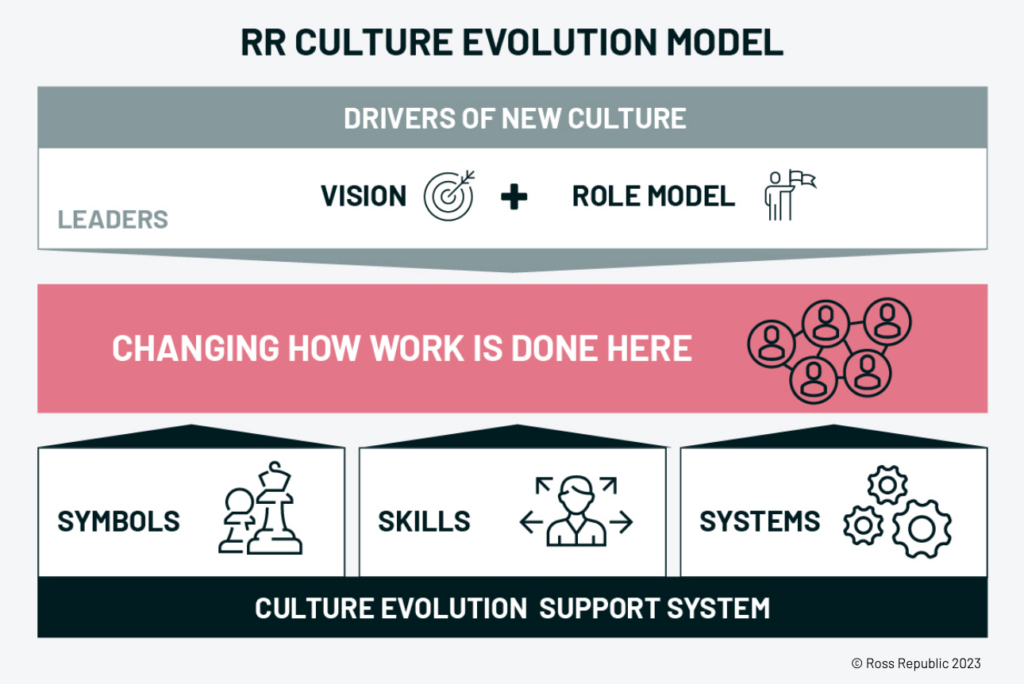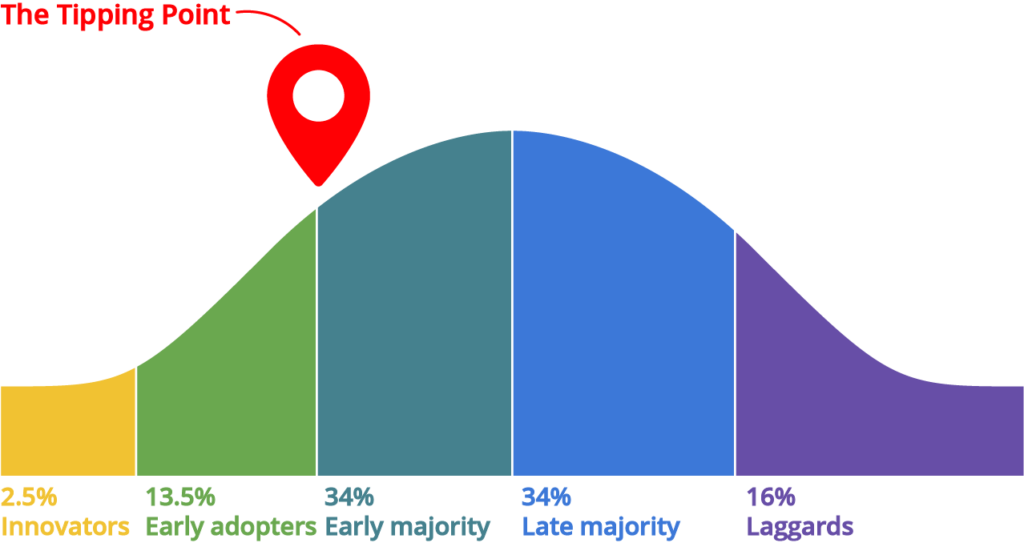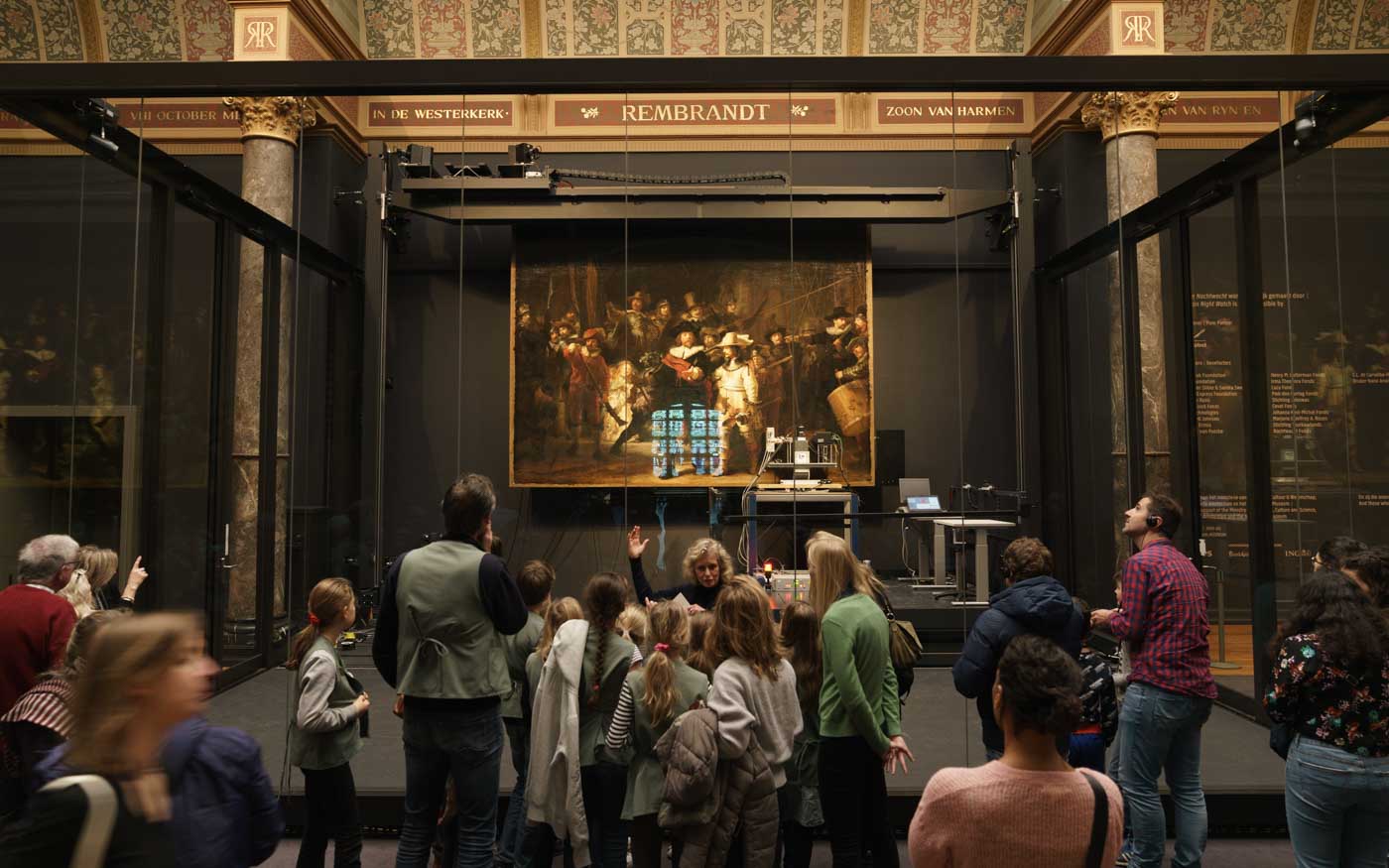Culture is an undisputed source of sustainable competitive advantage and a performance lever. “Culture eats strategy for breakfast” is a top business catchphrase. Yet leaders often see it as a mere people topic unrelated to day-to-day business operations, outsourcing its management to HR. What if almost everything we know about culture and how to manage it is wrong?
A case for active culture change management
In today’s competitive, fast-changing and complex world, planning, executing, and continuously adapting are key to an organisation’s performance and survival. Companies hire and promote change-makers and run transformation programs. They aim to build an efficient core and new capabilities enabling the company to meet new expectations, enter new markets and generate additional revenue streams.
Many transformation leaders find themselves in very small spaces to operate with, working with managers whose main concern is risk and cost management and employees who are disengaged and hard to mobilise.
The paradox is that, despite the lofty transformation statements, many transformation leaders find themselves in very small spaces to operate with, working with managers whose main concern is risk and cost management and employees who are disengaged and hard to mobilise. When asked about the most common culprit, the organisational culture is one of the primary reasons. Unmanaged culture deprives companies of being in touch with market-led developments and having united effective management teams. It makes them slow to react to changes with relevant actions which frustrates ambitious employees. If this is the case, culture should be a fixed element on every leader’s daily agenda, toolbox and KPIs.
Do we really know what culture eats?
Despite its importance, there is surprisingly little systematic research on evolving culture successfully. Business literature tells us that culture transformations usually fail, just as strategy implementations often unravel. Depending on the source, it is estimated that 60-90 per cent of strategy executions and 70 per cent of culture change projects fail. This begs a few questions: How can one succeed in something in which others have repeatedly failed? Why have others failed so as not to make the same mistakes? How should I shift my mindset to leverage culture successfully?
Culture is larger than people
Managers often position culture as a soft people topic. This narrow view sees culture as people’s beliefs, mindsets and behaviours. The view is not wrong, as deep beliefs and mindsets form the cultural identity which drives day-to-day behaviours; what people say and do at work. As culture is the human glue that makes companies unique, people permanently shifting their beliefs, mindsets and behaviours is the ultimate manifestation of culture change succeeding.
The people-centric ignores three important factors.
- Wanted, and unwanted, behaviours never occur in a vacuum. They are always guided and maintained by the context.
- To change people’s conduct you need to change the context.
- Reconfiguring the context is a faster route to change behaviours than focusing on changing beliefs only. New routines and rituals people to work in new ways and the new ways, if they deliver better results, motivate people to change their minds.
RR’s culture model: From a vision to systems
A modern approach is to see culture as an interlinked system with five elements. Leaders play the main role as Visionaries and Role-models, and Symbols, Skills and Systems are the indispensable Support System. Together, these elements define how work is done.

RR culture evolution model
People can be inspired to change by visionary leaders, and culture evolution is no exception. Consequently, the first prerequisite for a culture to evolve is a leader having a clear vision of how work should be done. The second is the leader, together with other change-makers, acting as a living symbol of the new way. The third is to pay attention to the support system which impacts people’s behaviours in three ways.
- Symbols make a memorable imprint of the new culture through branded elements and shared moments and rituals that build commonality and internal trust. Never underestimate the power of symbolism, yet never rely only on it.
- Skills form the basis for the new capabilities needed for future success. Remember that growth mindset is a soft skill that enables the evolution of all other skills.
- Systems are frameworks that define how day-to-day work is done and for what people are rewarded. The Systems are the “hardest” part of the culture, ranging from role descriptions to function-specific processes, cross-functional operational models, performance management and incentive systems, and organisational structures.
In the systems-based approach, a culture leader is like a modern general manager who understands how the soft and hard elements contribute to the culture in a given situation, skilfully using them with subject matter experts for the best results.

RR culture evolution model
The necessity to align day-to-day work to the vision
The narrow view of the culture leads companies to run traditional culture transformation programs that mainly focus on the visionary and symbolic elements and ignore the importance of translating words into day-to-day operations, which never happens without the hard and practical elements of culture.
The misunderstood element of culture is that meaningless work is in fact a product of the prevailing culture.
Whereas the vision is a precondition for setting change in motion, the hard elements align day-to-day work to it and answer “what’s in it for me”. They equip employees with new skills, improve their daily grind by removing demotivating obstacles that waste talent, time and effort and introduce new modern methods and tools that enable teams to work better, faster and stronger.
According to research by MIT Sloan School of Management, meaningfulness at work is something that employees find for themselves. Finding meaning is an individual process, and the organisation’s purpose can deepen the meaning if an employee shares the purpose. The research results do not question the importance of a purpose, yet they communicate that a lofty purpose should not overshadow other, more tangible elements that impact work. Things that are more achievable to every manager.
In contrast, meaningless work is something that organisations actively cause. The usual suspects for it are the feeling of the organisation not being aligned with the whole spectrum of market developments, lack of autonomy and support, valueless bureaucracy, ineffective decision-making and unnecessary manual work with dated tools among others. The misunderstood element of culture is that meaningless work is in fact a product of the prevailing culture. After all, everything what we do at work is affected by culture. Day in, day out.
It is easy, even tempting, to overestimate the importance of one defining, visionary moment and underestimate the value of making small meaningful improvements that impact day-to-day employee experience positively. A relentless focus on the day-to-day is the most tangible expression of the culture change being real. It is a credibility factor.
Conclusion: To change the conduct, one needs to change the context. A healthy culture requires an active nurturing of soft and hard elements of culture. Remember that optics and big size matter very little; positive small day-to-day experiences do.
Organisational culture as the first resource
Due to its reputation as a tricky topic, culture is too often used on an organisational level as a last resort. It is the final scapegoat that needs a makeover when all other means have been exhausted with lacklustre results. When the top management finally wakes to the need to work on it, often due to the BoD putting pressure on them, they face a monumental task.
The risk of letting the culture drift is a company having a strong unhealthy culture. Cultural strengths from the past have slowly become irrelevant yet left untouched. No new cultural traits have been embedded into management systems and operations. Counterproductive behaviours have become the norm. The stronger the unhealthy culture, the harder it is to change. A permanent change rarely happens without a new CEO and the composition of top management changing.
Conclusion: The longer the culture is left to drift, the greater the need for more radical episodic culture transformations and the smaller the odds of success. Leaders and employees should systematically nurture culture, seeing its management as a natural part of day-to-day operations.
The power of one supported by team effort
Even though culture is a collective force, evolving it is an individual responsibility. Leaders often see it as “a thing” instead of something they can personally change, which is not correct, as culture evolves continuously whether managed or not.
Together, the cross-functional and cross-vertical coalition form a team of torchbearers for the change-resistant majority.
Active culture management takes ”only” a leader with a cultural vision and understanding, using voice, acting as a role model, ignoring the formal company structures and building horizontal and vertical coalitions with other change-makers. Together, the cross-functional and cross-vertical coalition form a team of torchbearers for the change-resistant majority.
Active culture management, or culture drifting, happens on four levels:
- Team
- Function
- Unit
- Organisation
While it is up to a team leader to build an effective team, building a high-performing company with shared goals and collaborative teams and a coveted workplace requires the commitment, championing, and efforts of the CEO and the top team.
Conclusion: Top-level, mid-level or lower-level leaders create culture daily, intentionally or unintentionally. The number and commitment of the people who assume individual responsibility and their ability to build interdependencies that multiply individual efforts will determine whether the culture will become a source of sustained competitive advantage.
The ultimate test of leadership
Being vague, pushing change from the top down and being inconsistent and weak are obvious no-go’s, yet not uncommon reasons for failure.
Effective culture leaders articulate what values are important to reach shared goals and desired business outcomes, what behaviours are expected, what counterproductive behaviours must end and how the new behaviours are supported. They ensure that the desired behavioural changes are reflected in the performance management and the recognition and reward systems. They understand that their own behaviour sets the new standard. Gaps between words and actions and frequent relapses will not do, as deeds communicate louder than words.
Strong leaders celebrate success and do not fear using penalty cards for those who resist.
Change happens when employees own it. Visionary leaders must find a balance between playing a role in intentionally defining the behaviours they expect to see and creating space for employees to shape the culture. Empowering leaders encourage and expect their teams to interpret the new rules and make them contextually relevant. While the values are the same, each team must come with their own set of actions that can be linked back to vision. Finally, strong leaders celebrate success and do not fear using penalty cards for those who resist. The most drastic penalty is a leader or an employee being demoted.
Conclusion: Culture evolution requires clarity on the new rules, strong and empowering leadership, celebrations, and subtle punishments.
Present evidence
Change-makers believe in order to see. Most employees need to see first to believe. They resist change until they see evidence of the new way of exciting troops and delivering better results.
The most effective way to win over the resistors is to link the new behaviours to positive business outcomes, have clear KPIs and frequently report on progress. As culture evolution is never a linear process, learn from mistakes in retrospectives to improve your plan based on open conversations. In this regard, culture transformations do not differ from any other transformation projects.
Conclusion: Have a few powerful culture KPIs that impact the shared goals, key business metrics and the bottom line. Be authentic, and do not hide the challenges you face along the way.
The usual triggers
There are a variety of triggers for the culture becoming a strategic topic and it being used as a leadership tool. A trigger to active culture management can be either proactive or reactive.
The most common proactive, positive triggers
- I want to be an effective, human leader
- I want to introduce culture as a strategic enabler and culture management as an essential leadership skill
- I want to make culture part of our strategic planning process to ensure the strategy’s effective execution
- I want our organisation to become [customer-obsessed – market-driven – innovative – add a word here_________ ]
- I want to build effective teams
- I want to increase organizational effectiveness
- I want my company to be a great place to work to attract critical talent
- I want our employees to fulfil their potential
- I want to ensure that our culture does not limit our future strategic options
The most common reactive, negative triggers
- We face strategy execution challenges
- Our leadership team is ineffective and distant
- We have mini-kingdoms, silos and harmful competition
- We have toxic sub-cultures with counteractive behaviours, even in high-performing parts of business
- Our current cultural weaknesses are greater than the cultural strengths of the past
- We feel imprisoned by our culture, cannot see and seize new opportunities, and change fast enough
- Employees’ talent, time and effort is wasted
- Employees are disengaged and dissatisfied
- Leavers mention culture as one of the key reasons for quitting
- We do not attract the talent we need
You did not find your trigger? Let us know and we will add to the list.
Culture process: How to get started?
Being a leader is a challenging task. The expectations are high, the business environment is constantly changing and unpredictable, the resources to deliver are often too few, and it is hard to find enough time to safeguard the core business and renew it. Leaders and their teams are constantly exposed to external factors outside their control. Culture as an internal factor is one of the few things over which they have control, something they can make work for their own and the organisation’s benefit.
These five steps will help to get started. Note that the process is a skeleton. Its detailed content depends on the level on which the culture is actively managed.
Have shared goals
Discussing culture without business goals is useless, as culture is means to an end. Note that having someone’s goals and having shared goals are two different things. Deep consensus on the goals and priorities is the essence of a strong culture.
Create action plan and culture scenarios
Use your normal action planning process and add the culture component to it. Define what kind of culture would optimally contribute to performance.
- How should people think and behave as individuals
- How should you collaborate as a team and with other teams
- What skills and capabilities are a must-have
- What kind of system would guide, motivate and enable your team to focus its energy on what matters?
You can also work backwards from the culture to actions to test whether your culture is becoming your prison. Ask yourselves: If we had cultural traits X, Y and Z, would our action plan be different?
Identify culture gaps
Codify the current cultural modus operandi and analyse it against the optimal culture scenarios to identify critical gaps. How your team reacts emotionally to the action plan and culture scenarios reveals your culture blockers. Some blockers are personal, some revolve around the leadership, maybe even one person, and some will question the system’s adaptability. Some of the blockers are real. However, many are inside people’s heads. Do not get stuck with the blockers if you do not have the mandate or budget to remove elephants that block your way. You can always find better ways to navigate the system and focus on how to use it.
Create your culture plan with clear KPIs
If you spot critical culture gaps, the question is: When, if not now, is the right time to start addressing the weaknesses that hold your team and organisation back? Are you and your team ready to make short-term extra sacrifices to make you a stronger team and build a better work environment for tomorrow?
Create a realistic culture evolution plan for your culture journey. Fix one of a few things at a time, and start with quick wins before you go after bigger obstacles. Define culture KPIs and link them to the KPIs of your action plan. Track your progress to adjust the plan to make keep it relevant. Keep your ultimate goal in mind, which is to work in a way that helps you to reach shared goals effectively and build a case for the new way to work to become the way to work.
Never stop internal marketing
According to the Law of Diffusion,
- 15 % of the population is actively open to change,
- 34 % wait for the 15 % to show the way before they embrace new ideas
- 34 % resist until they see the results that show the new ideas work
- 16 % are never won over.

Law of diffusion
Image credits: uxdesign.cc
As a culture leader, you have three milestones. You and your coalition must first convince 15 % of the employees that a new way is better. Then you go after the hearts and minds of the 34 % and, finally, the other 34%. An effective culture leader is also an internal marketer with excellent peer-to-peer marketing skills. What are you selling, then? An opportunity to learn to work better, to be a better team player and contribute to the organisation’s future.
From siloed theory to holistic culture practise
What works for determined individuals in their personal lives also works for teams driven by a shared vision in the professional context. James Clear, the author of Atomic Habits and an expert in how people learn new habits writes: “If you’re having trouble changing your habits, the problem isn’t you. The problem is your system. Bad habits repeat themselves again and again not because you don’t want to change, but because you have the wrong system for change.”
He also writes: “Changing your beliefs isn’t nearly as hard as you might think. There are two steps.
- Decide the type of person you want to be
- Prove it to yourself with small wins. Your identity emerges out of your habits. Every action is a vote for the type of person you wish to become.”
Culture surrounds us in everything we do, and everyone contributes to it. As such, it should be owned by every leader and employee and managed by a cross-functional and cross-vertical coalition instead of one function. The higher up the coalition sits, the more impactful it is.
The CEO is always the ultimate owner of the culture on an organisational level. They decide whether culture is a strategic priority, or no priority. Large-scale culture transformations always require her 100 % commitment. They need a coalition that also consists of members who are not part of senior management. The versatility and strength of the coalition matters, not the rank.
What if you are not a CEO? A CEO ignoring the culture does not mean you cannot work on it, yet you have less wiggle room. Remember that in many cases, it is someone other than the CEO who first raises the importance of active culture management and brings it to the management team’s attention.
“You cannot manage men into battle. You manage things; you lead people.” – Grace Hopper (retired Admiral, U.S. Navy)
Good luck to your culture journey!
I am always available to discuss how to build better teams, better workplaces and more successful businesses though RR’s systems-based culture approach. Get in touch with me via LinkedIn or through this form.

About the author


